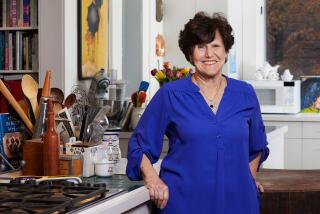Ina Garten targets real-world cooks in ‘Barefoot Contessa Back to Basics’
Judging from some of the most popular titles of the recent holiday season, you might think the only reason people bought cookbooks was to talk about them.
Let’s see, we had “Under Pressure,” Thomas Keller’s book on sous-vide cooking, which is probably quite remarkable if you have the $2,500 to invest in the equipment necessary to cook from it. Then there was Grant Achatz’s “Alinea,” which, if anything, is even more beautiful than “Under Pressure” and even more impossible to use -- you’d practically have to buy out a chemical supply store first. And let’s not even get started on Heston Blumenthal’s “The Big Fat Duck Cookbook,” which is certainly the biggest of the books (it weighs more than 10 pounds, including slipcover), and maybe the most beautiful -- and at $250 certainly should be.
But what if you just want to cook dinner? Has the food world become so obsessed with theory and experimentation that feeding family and friends has become an afterthought?
Not as long as Ina Garten is around. The down-to-earth caterer turned cookbook author’s new “Barefoot Contessa Back to Basics” is the kind of book you want to thrust into the hands of every cookbook editor and say, “Here’s how you do it, just like this.”
Perhaps more to the point, it’s also the kind of book you want to thrust into the hands of every beginning cook and say, “See, it’s not so hard.”
How often have you sat at the table of some trembling home cook while he or she trotted out plate after plate of sad food -- overthought and over their heads, as far as cooking technique goes. It’s no fun for the eaters, and it never looks like much fun for the cooks either.
Simple yet satisfying
But preparing food that tastes good doesn’t have to be so complicated. That’s the secret of Garten’s success (and some success it is: six cookbooks with hundreds of thousands of copies sold, regular columns in three major magazines and, of course, a long-running Food Network series).
The essence of Garten’s cooking is creating dishes that can be prepared with half the fuss and still taste three-fourths as good. If that sounds like damning with faint praise, you really ought to give the book a shot and see.
Try her chicken bouillabaisse, for instance. There doesn’t seem to be anything all that remarkable about the recipe; essentially it’s nothing more than a cut-up bird braised in tomato sauce, served with a garlicky mayonnaise.
You can certainly find preparations more complicated, but what makes Garten’s version stand out is the way she pared down the recipe to its essentials and still wound up with a dish that doesn’t betray the spirit of the original.
Somehow that braising sauce -- basically tomato purée, chicken stock and white wine doctored up with garlic, saffron, fennel seeds and a glug of Pernod -- becomes something that, while certainly not mind-blowing, tastes really, really good. The garlic rouille served alongside is a similar shortcut with an equal payoff.
Highs, a few lows
This is not to suggest that the book is perfect. Many of these recipes would have been made doubly useful to a less-experienced audience with the inclusion of teaching points -- little tips that would educate the beginner rather than just give him a dinner party recipe.
But it’s hard to argue with the success of her prosciutto-roasted bass with autumn vegetables. Wrap a slice of prosciutto around a filet of fish and then roast it on a bed of root vegetables. That’s basically it. It’s beautiful, it’s delicious, and it’s the kind of thing a reasonably talented (though perhaps unreasonably sophisticated) 11-year-old could pull off without any problem.
And it’s a recipe I want to photocopy and hand out to some of those overambitious home cooks I’ve run into. Feed your guests this and they’ll be happy, I’d tell them. Just as important, you will be too.
This may not be the kind of food that will set an experienced cook’s heart aflutter. (It defiantly is not the kind of recreational cooking that will eat up a lazy Saturday afternoon.)
But one real measure of a cookbook’s success is how dog-eared and sauce-stained it gets. Call it the difference between shelf appeal and kitchen counter appeal. And by that standard, Garten has the more-talked-about books of the year beat by a mile.
More to Read
Sign up for our L.A. Times Plants newsletter
At the start of each month, get a roundup of upcoming plant-related activities and events in Southern California, along with links to tips and articles you may have missed.
You may occasionally receive promotional content from the Los Angeles Times.







